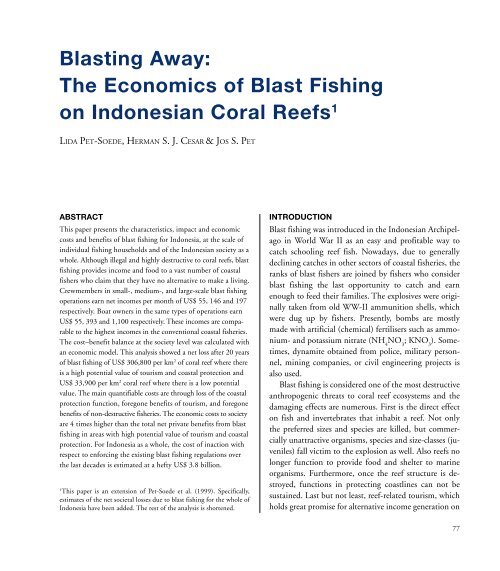You also want an ePaper? Increase the reach of your titles
YUMPU automatically turns print PDFs into web optimized ePapers that Google loves.
Blasting Away:<br />
The <strong>Economics</strong> <strong>of</strong> Blast Fishing<br />
on Indonesian <strong>Coral</strong> <strong>Reefs</strong> 1<br />
LIDA PET-SOEDE, HERMAN S. J. CESAR & JOS S. PET<br />
ABSTRACT<br />
This paper presents the characteristics, impact and economic<br />
costs and benefits <strong>of</strong> blast fishing for Indonesia, at the scale <strong>of</strong><br />
individual fishing households and <strong>of</strong> the Indonesian society as a<br />
whole. Although illegal and highly destructive to coral reefs, blast<br />
fishing provides income and food to a vast number <strong>of</strong> coastal<br />
fishers who claim that they have no alternative to make a living.<br />
Crewmembers in small-, medium-, and large-scale blast fishing<br />
operations earn net incomes per month <strong>of</strong> US$ 55, 146 and 197<br />
respectively. Boat owners in the same types <strong>of</strong> operations earn<br />
US$ 55, 393 and 1,100 respectively. These incomes are comparable<br />
to the highest incomes in the conventional coastal fisheries.<br />
The cost–benefit balance at the society level was calculated with<br />
an economic model. This analysis showed a net loss after 20 years<br />
<strong>of</strong> blast fishing <strong>of</strong> US$ 306,800 per km 2 <strong>of</strong> coral reef where there<br />
is a high potential value <strong>of</strong> tourism and coastal protection and<br />
US$ 33,900 per km 2 coral reef where there is a low potential<br />
value. The main quantifiable costs are through loss <strong>of</strong> the coastal<br />
protection function, foregone benefits <strong>of</strong> tourism, and foregone<br />
benefits <strong>of</strong> non-destructive fisheries. The economic costs to society<br />
are 4 times higher than the total net private benefits from blast<br />
fishing in areas with high potential value <strong>of</strong> tourism and coastal<br />
protection. For Indonesia as a whole, the cost <strong>of</strong> inaction with<br />
respect to enforcing the existing blast fishing regulations over<br />
the last decades is estimated at a hefty US$ 3.8 billion.<br />
1<br />
This paper is an extension <strong>of</strong> Pet-Soede et al. (1999). Specifically,<br />
estimates <strong>of</strong> the net societal losses due to blast fishing for the whole <strong>of</strong><br />
Indonesia have been added. The rest <strong>of</strong> the analysis is shortened.<br />
INTRODUCTION<br />
Blast fishing was introduced in the Indonesian Archipelago<br />
in World War II as an easy and pr<strong>of</strong>itable way to<br />
catch schooling reef fish. Nowadays, due to generally<br />
declining catches in other sectors <strong>of</strong> coastal fisheries, the<br />
ranks <strong>of</strong> blast fishers are joined by fishers who consider<br />
blast fishing the last opportunity to catch and earn<br />
enough to feed their families. The explosives were originally<br />
taken from old WW-II ammunition shells, which<br />
were dug up by fishers. Presently, bombs are mostly<br />
made with artificial (chemical) fertilisers such as ammonium-<br />
and potassium nitrate (NH 4<br />
NO 3<br />
; KNO 3<br />
). Sometimes,<br />
dynamite obtained from police, military personnel,<br />
mining companies, or civil engineering projects is<br />
also used.<br />
Blast fishing is considered one <strong>of</strong> the most destructive<br />
anthropogenic threats to coral reef ecosystems and the<br />
damaging effects are numerous. First is the direct effect<br />
on fish and invertebrates that inhabit a reef. Not only<br />
the preferred sizes and species are killed, but commercially<br />
unattractive organisms, species and size-classes (juveniles)<br />
fall victim to the explosion as well. Also reefs no<br />
longer function to provide food and shelter to marine<br />
organisms. Furthermore, once the reef structure is destroyed,<br />
functions in protecting coastlines can not be<br />
sustained. Last but not least, reef-related tourism, which<br />
holds great promise for alternative income generation on<br />
77


















